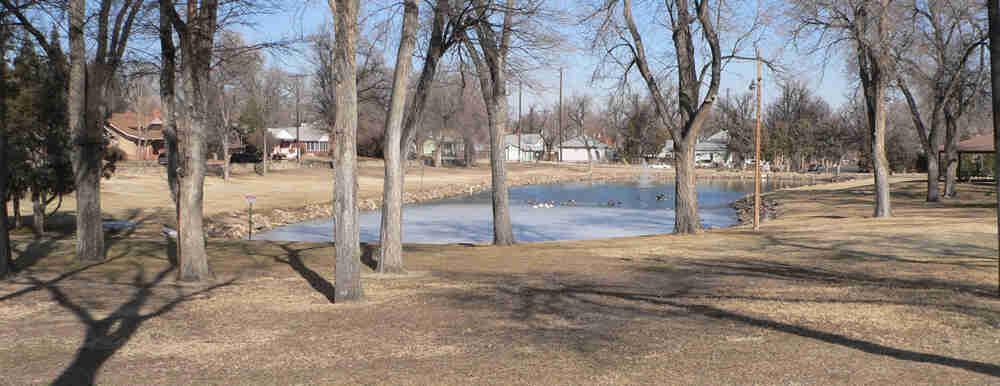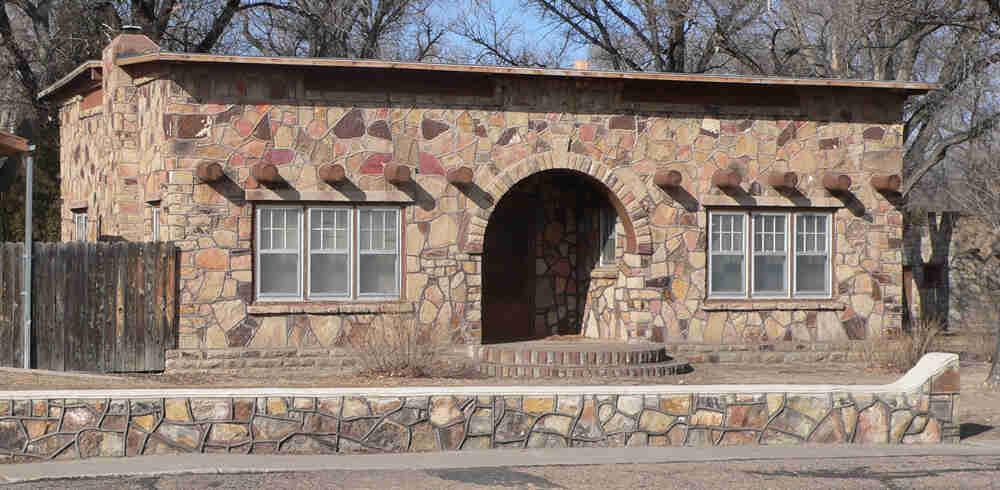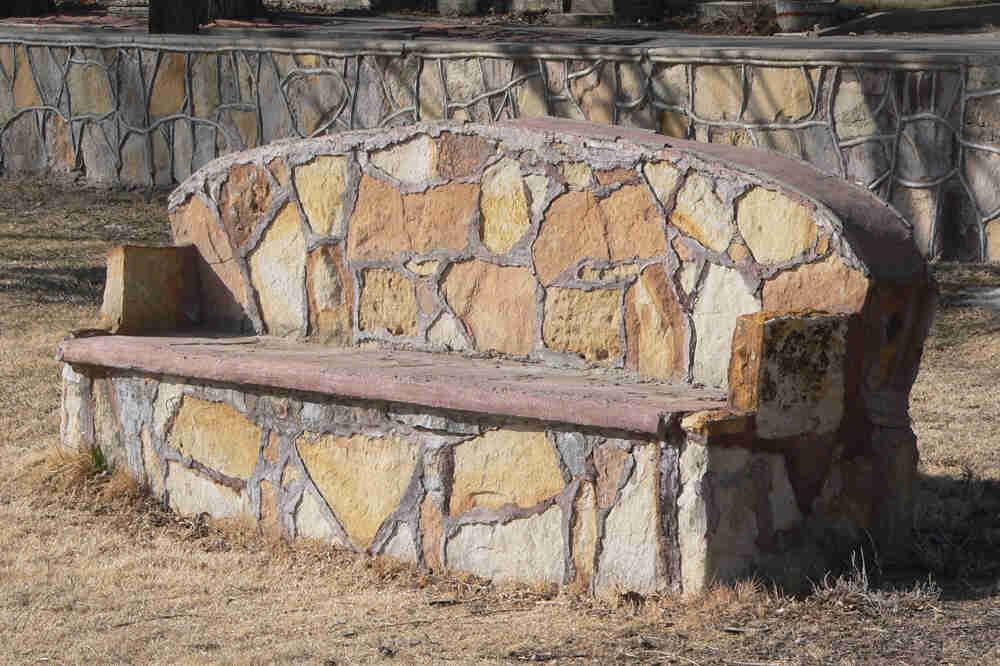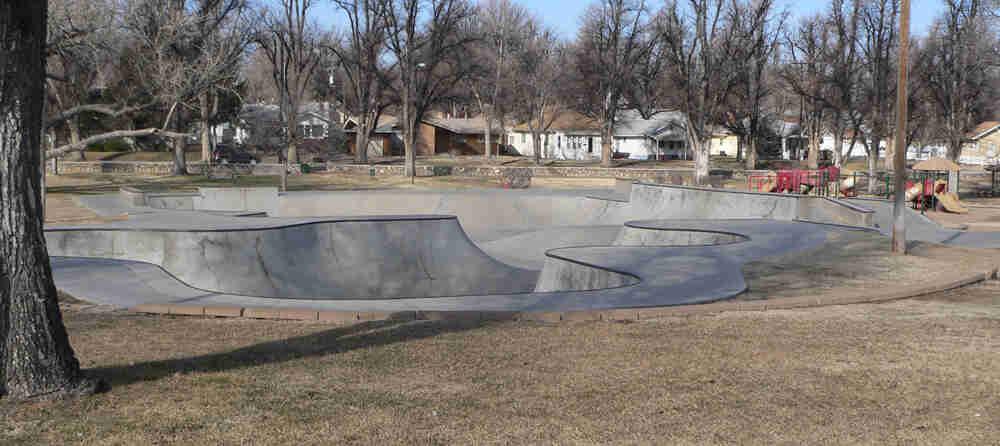La Junta City Park
Full Article
La Junta City Park is a prime example of a New Deal project on Colorado’s eastern plains. As a result of work carried out between 1933 and 1941, a poorly drained park became the city’s primary outdoor recreation space, complete with stone walls, benches, and buildings; a new lake; picnic shelters; and tennis courts. The park continues to be a popular place for walking, picnicking, and playing tennis and basketball.
Origins and New Deal Development
In 1905 La Junta bought 16.5 acres south of downtown for one dollar and made the land into City Park. The new park was half a mile away from downtown, however, and the land had poor drainage. Few improvements were made, resulting in infrequent use of the park.
City Park was reborn in the 1930s, when New Deal projects carried out by the Civil Works Administration (CWA) and Works Progress Administration (WPA) transformed the park. The CWA, a temporary work-relief program, began working in the park on November 27, 1933, focusing on improving the park’s drainage system. The CWA completed its project in the spring of 1934.
In August 1935 the city submitted a WPA project proposal to renovate the park. The plan called for new walks, driveways, lakes, and landscaping, including stone walls around the park’s perimeter. The WPA approved the proposal, which received more than $40,000 in federal funds in addition to the city’s contribution of more than $5,000. Work began in May 1936 with a forty-man crew. In keeping with the WPA’s emphasis on local materials and labor-intensive, handcrafted construction, stone for the park’s walls was quarried from a site near Higbee, not far south of La Junta.
The WPA’s work took longer than expected, in part because a massive flood in May 1937 inundated the park and put the project on hold for eight months. Probably as a result of the flood, the WPA revised its original plan for four lakes and decided to build just one large lake in the northwest corner of the park.
After the WPA’s initial work was completed, the city submitted another WPA project proposal in July 1938. This project, which received nearly $33,000 in federal and local funds, called for building tennis courts, a caretaker’s house, restrooms, and a sprinkler system, among other improvements. The construction and landscaping were completed by February 1941.
The WPA approved a third City Park project in March 1941. This project was meant to complete improvements in the park and was supposed to receive more than $12,000 in federal and local funds. There is no record of the work in WPA files, however, and it is unclear whether the project went forward.
City Park Today
The basic layout of City Park has not changed since the WPA completed its improvements in 1941. Local Boy Scouts placed a miniature replica of the Statue of Liberty in the park in 1951 as part of a nationwide program to celebrate the organization’s fortieth anniversary. More recent additions—including basketball courts (1990), a playground (1999), and a skate park (2003)— have primarily enhanced the park’s functionality without detracting from the historical value of the WPA’s design. Recent grants from the State Historical Fund have allowed for park restoration work.
10th Grade
La Junta City Park is an example of a New Deal project on Colorado’s Eastern Plains. Because of work carried out between 1933 and 1941, a poorly drained park became the city’s primary outdoor recreation space. It features stone walls, benches, and buildings, as well as a lake, picnic shelters, and tennis courts. The park continues to be a popular place for walking, picnicking, and playing tennis and basketball.
Origins and New Deal Development
In 1905 La Junta bought sixteen and a half acres of land south of downtown for one dollar and made it into a city park. However, the new park was half a mile from downtown and the land had poor drainage. Few improvements were made, resulting in infrequent use of the park.
City Park was reborn in the 1930s. New Deal projects, carried out by the Civil Works Administration (CWA) and Works Progress Administration (WPA), transformed the park. The CWA and the WPA were work-relief programs designed to reduce massive unemployment during the Great Depression. The CWA began working in the park on November 27, 1933, focusing on improving the park’s drainage system. The project was completed in the spring of 1934.
In August 1935, the city submitted a WPA project proposal to renovate the park. The WPA approved the proposal and allotted $40,000 in federal funds. The city of La Junta contributed around $5,000. Work began in May 1936 with a forty-man crew. New walks, driveways, lakes, gardens, and landscaping were added to the park. Handcrafted stone walls were erected around the park’s perimeter. The WPA had an emphasis on using local materials and labor-intensive construction. Stone for the park’s walls and benches was quarried from a local site near Higbee, south of La Junta.
The WPA’s work on this project took longer than expected, in part because an enormous flood in May 1937 engulfed the park. The project was put on hold for eight months. Because of the flood, the WPA revised its original plan for four small lakes and decided to build just one large lake in the northwest corner of the park.
After the initial work was completed, the city submitted another WPA proposal in July 1938. This project was awarded $33,000 in federal and local funds. The project added tennis courts and a caretaker’s house. Restrooms and a sprinkler system were also included. The construction and landscaping were completed by February 1941.
The WPA approved a third City Park project in March 1941. This project was meant to complete improvements in the park. It was supposed to receive more than $12,000 in federal and local funds. There is no record of the work in WPA files, however, and it is unclear whether the project went forward.
City Park Today
The basic layout of City Park has not changed since the WPA completed its improvements in 1941. Local Boy Scouts placed a miniature replica of the Statue of Liberty in the park in 1951. Recent additions include basketball courts (1990), a playground (1999), and a skate park (2003). These have enhanced the park without detracting from the historical value of the WPA’s design. Recent grants from the State Historical Fund have allowed for additional park restoration work.
8th Grade
La Junta City Park was built between 1933 and 1941, during America’s Great Depression. The US government hired men who were out of work to complete projects that helped communities. They transformed La Junta City Park into a beautiful, usable space with stone walls, benches, and buildings. A new lake, picnic area, and tennis courts were added. Today the park is a popular place for walking, picnicking, and skateboarding.
Origins and New Deal Development
In 1905 La Junta bought sixteen and a half acres south of downtown for one dollar and made the land into City Park. However, the new park was a half mile from downtown and the land had poor drainage. Few improvements were made, and the park was rarely used.
The Great Depression started in 1929 and left millions of Americans out of work. President Franklin Roosevelt started government programs that paid workers to do projects around the country. These were called “New Deal” projects. Two programs helped build La Junta’s City Park: the Civil Works Administration (CWA) and the Works Progress Administration (WPA.) These New Deal programs made the park into a centerpiece of the town.
The city of La Junta asked the government to help improve its park. The CWA began working in the park in November 1933, focusing on improving its drainage system. The CWA completed its project in the spring of 1934.
In August 1935, the city submitted a WPA project proposal to renovate the park. The WPA allotted $40,000 in federal funds, and the city of La Junta added $5,000. Work began in May 1936 with a forty-man crew. The plan called for new walks, driveways, lakes, and landscaping. It included stone walls around the park’s perimeter. The WPA used local materials; for instance, stone for the park’s walls was quarried from Higbee, a town near La Junta.
The project took longer than expected because of a massive flood in May 1937. The project was put on hold for eight months. Because of the flood, the WPA revised its original plan, which called for the construction of four small lakes. It was decided to build just one large lake in the northwest corner of the park.
After the initial work was completed, the city submitted another WPA proposal in 1938. This project was awarded $33,000 in federal and local funds. It called for building tennis courts and a caretaker’s house. Restrooms and a sprinkler system were also included. The construction and landscaping were completed in 1941.
The WPA approved another City Park project in March 1941, meant to complete improvements in the park. It was supposed to receive more than $12,000 in federal and local funds. However, there is no record of the work in WPA files and it is unclear whether the project went forward.
Today
The WPA completed its improvements to La Junta City Park in 1941. In 1951 the La Junta Boy Scouts placed a miniature replica of the Statue of Liberty in the park. Recent additions include basketball courts (1990), a playground (1999), and a skate park (2003).
These have enhanced the park’s amenities without detracting from the historical elements of the WPA’s design. Recent grants from the State Historical Fund have allowed for additional park restoration work.
4th Grade
La Junta City Park was built between 1933 and 1941, during America’s Great Depression. The US government hired men who were out of work. The men were paid to complete projects that helped communities. They made La Junta City Park into a beautiful, usable space. Stone walls, benches, and buildings were built. A new lake, picnic area and tennis courts were added. Today the park is a popular place for walking, picnicking, and skate boarding.
Origins and Development
In 1905 La Junta bought sixteen acres of land near downtown for just one dollar. They wanted to make it into a City Park, but the land was a half mile from downtown and had poor drainage. The town never made it into a park.
The Great Depression started in 1929. Millions of Americans were unemployed. President Franklin Roosevelt started some government programs that paid workers to work on projects around the country. These were called “New Deal” projects. Two programs helped build La Junta City Park: the Civil Works Administration (CWA) and the Works Progress Administration (WPA). New Deal projects made the park into a centerpiece of the town.
The town of La Junta asked the government to help create a park on the land. The CWA began working on their first project in 1933. This project improved the drainage system. The project was completed in the spring of 1934.
A second project was started in 1936. The project cost $45,000. Forty men were on the work crew. This project added walks, lakes, trees, and gardens. Handmade stone walls went around the park. Stone benches were also added. The WPA used local materials in their projects. The stone for the park’s walls and benches were from Higbee, a town near of La Junta.
This project took longer than expected. There was a huge flood in May 1937. The project was not able to continue for eight months. After the flood, the WPA changed its plans. The original plan was to create four small lakes. It decided to build one large lake instead.
After this work was done, another WPA project began. This project cost $33,000. Tennis courts and a caretaker’s house were built. Restrooms and a sprinkler system were added. This was completed in 1941.
One more WPA project was planned in 1941. This project was to improve the park. It was supposed to receive $12,000. But for unknown reasons, this project was never started.
City Park Today
The WPA finished its improvements in 1941. In 1951 the La Junta Boy Scouts added a small Statue of Liberty to the park. These were put into parks all over the country to celebrate the Fortieth Anniversary of the Boy Scouts. Other improvements have been made over the years. These included basketball courts in 1990, a playground in 1999, and a skate park in 2003.




















